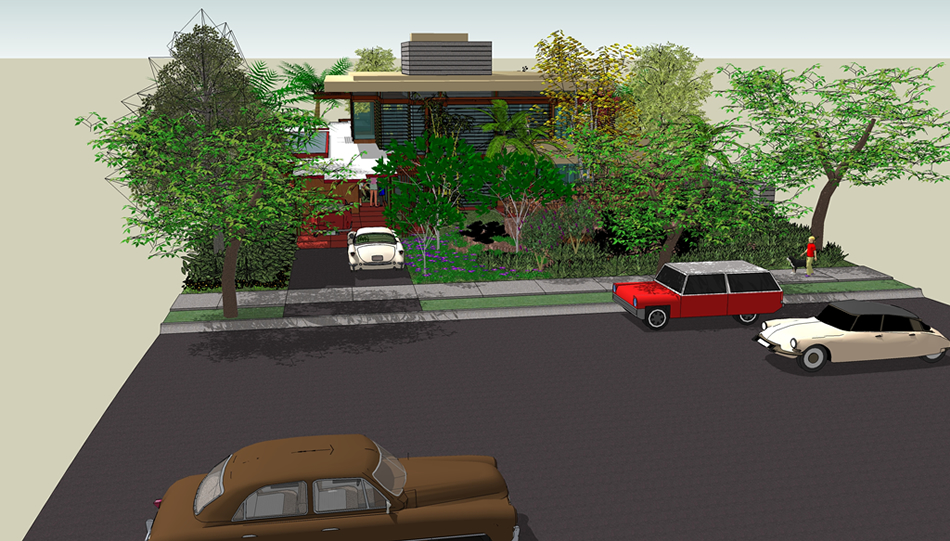The Hoover House
@ 50 Years - a scenario |
notes on the art of making and keeping domestic architecture |
| Works of architecture are rarely maintained and upgraded over time in a systematic way. Usually, for the first decade, the owners ride on the capital investment putting off maintenance and upgrades until forced to do so. Often in the past, perhaps this will be less so in the future, people moved to a new house when their requirements changed. |
| This habit has aided the boom and bust cycles of real estate sub divisions as houses are economically passed down like old cars. In commercial real estate there is the point where the original owner, having derived the most profit for the least cost, sells passing the first major maintenance costs on to the new buyer. |
| This makes short term cash flow sense but is not good economics nor ecology over the long run. Sometimes, valuable works, which have gone to ruin, are rescued and brought back to life usually at great cost. |
| One of my goals with the Hoover House design was to build a work that would avoid this vicious cycle. It was not to be so now, 50 years later, I am free to present a scenario as it could have been. |
|
|
| A Taylor Axiom is “you can’t get THERE from her, but you can get HERE from THERE.” |
| The Hoover house was one of three designs I completed in 1960 just prior to moving to NYC to add to my construction experience. The other two, the American Pool Building and the Cooper House, were compositions in circles to be built out of Gunite (sprayed concrete). They were considered, at the time, to be much more radical than the Hoover House which was to be executed in the “classic” SoCal modern idiom typical of the post WWII period. |
| Yet, in many ways, the Hoover House was full of innovations which took me many years to fully explore and develop. It became, as the decades passed, one of my un built works which I most mourned and came to realize was a seminal work in my development. |
| It is shown here as if it was completed, then modified as intended in the original design, and then expanded as I would have done it if the Hoover family had built it, used it, and lovingly kept it in perfect shape over a half a century. |
|
|
| Although I have been using Sketch Up for a number of years now and slowly gaining some competency with it, this is my most ambitious attempt thus far. |
| The goal is to represent the design concept with technical accuracy and graphic realism while showing the building in use at various specific moments in time. This better demonstrates the reality of architecture which is a continuous process of design, build, use over a lengthily period of time. The work is not “done” upon the building “completion” and first occupancy; indeed, the greatest creative effort is still ahead. The world today, the building as built rarely is as good as the original sketch and, when built, the building proceeds to decline almost never again matching its first appearance. |
| The story of most designs is a long one of compromise after compromise during the design build phases followed by increasingly rapid deterioration after construction.This is a triple blow to art, economics and ecology. What if another process was employed? How would this work? what would it look like? This is what this Model is built to show. This poses the important question what if we start to built this way? |
|
|
|
| The concept is a residence that - when fully developed - has four major living spaces, each with direct access from without, each that can be configured in a variety of ways to meet an extensive, changing set of individual and extended family requirements, without promoting short term compromise or extensive remodeling. |
| Further, that each of these areas had the choice, on a band width of minutes to days and weeks, of fully interface with the other areas as well as wanted degrees of privacy with direct access to their own individual gardens. And, that the building could be an entirely floor-to-ceiling glass encased house - with all the benefits of this amenity - without sacrificing privacy and a user controlled reality of on-demand prospect and refuge. |
| In addition that over time, the property, a typical sub division lot of the era, could make a significant contribution to the energy and food requirements of the family, and - even as it protects the family - be a friendly presence in the community and contribute to the community commons while being realized over time as the budget allowed. |
|
|
|
| At the time I designed the Hoover House, in late 1959, I had three years of professional experience including a brief stay with Frank Lloyd Wright at Taliesin and full week visit of personal tutelage with Bruce Goff. My work during this period was doing track housing from low to upper cost subdivisions of hundreds of houses per project. This was the post WWII building boom at its peak. |
| I performed all the tasks from plotting the subdivisions, through working drawings and shepherding the work through building departments. My duties stopped at the beginning of construction. To fill in for this gap, between projects (which came and went in rapid boom and bust cycles) I worked on a pool construction crew gaining experience in gunite, concrete, steel tying, electrical, tile setting, etc. |
| Somehow in mist of this nearly 24/7/365 work effort I fell in love (for the first time) with a wonderful young lady but “lost” her, as her mother did, to a marriage with another - which both of us gave way to but opposed. The mother and I subsequently grew very close and this house was the result produced, full of embedded passion, by a very befuddled young man. |
|
|
| Started in July, 2011 this presentation will take considerable time to complete. The Sketch Up model as of the first posting, was over 100 mega bytes and still lacked full interiors and finished landscaping. |
| The intention is to show the family gathering, July weekend, 2011 of the 50th year anniversary of the first completion of the structure then work backwards to how the house would have been at various periods over that half century. |
| Thus, the story and the presentation, including the 3d model, will unfold most likely through much of 2012 as the work is great and the possible time away from contemporary projects small. Nevertheless, there will be value from the beginning and you may want to return from time to time to see the totality of the idea as it comes to life. What will be revealed is a concept of architecture, how it is created and evolved, which is different than has been the common “practice” through the first decade of this century. The consequence of this over the past decades, and the implications for the future, I leave to your judgment. |
|
|
click on the drawings and pictures below to go to supporting documents |
| the synergy of the pieces... |
| The Parts and the Whole... |
|
|
|
|

SolutionBox
voice of this document:
VISION • STRATEGY
DESIGN DEVELOPMENT
|
| |
click on graphic for explanation of SolutionBox |
|
|
| Return
To postUsonain Project |
|
|
| Return
To postUsonain Index |
|
|
|
posted: July 4, 2011 • revised November 20, 2011 - 4:47 AM @ Nashville Studio • © 1959, 1960, 2007, 2011 Matt Taylor |
|

